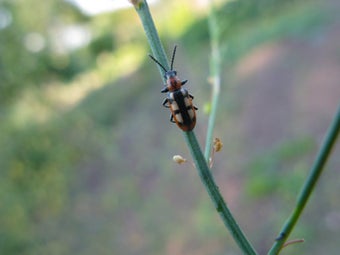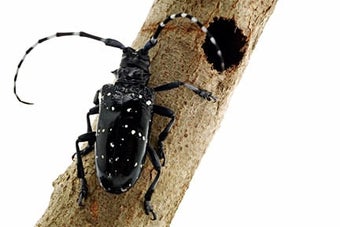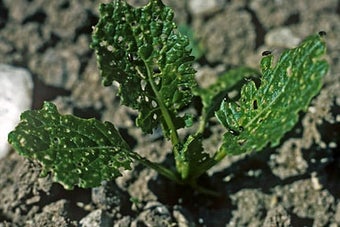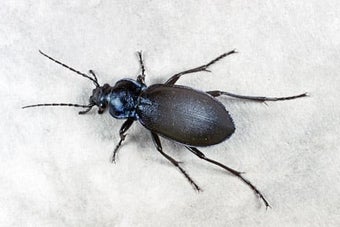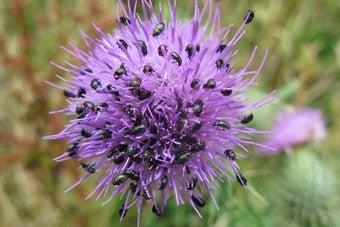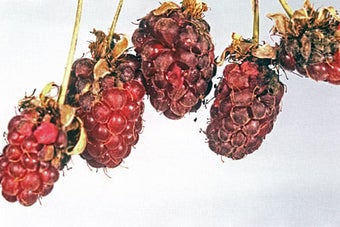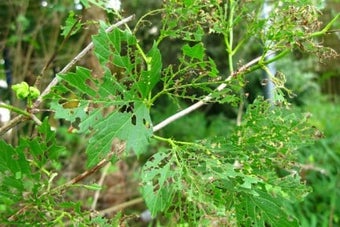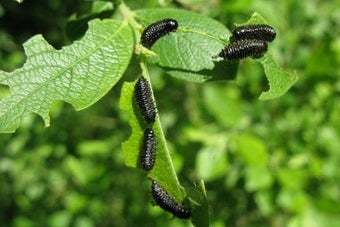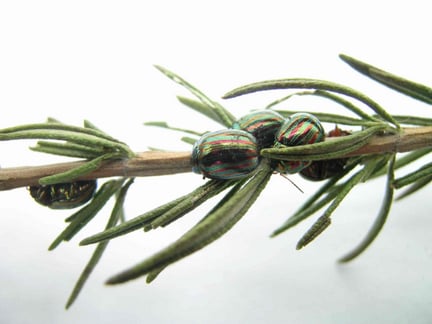
Quick facts
Common name - Rosemary beetle
Scientific name - Chrysolina americana
Plants affected - Rosemary, lavender, sage, thyme and some other related plants
Main symptoms - Foliage eaten where beetles and grubs have been feeding
Most active - August-April; adult beetles present throughout the year
What is rosemary beetle?
Rosemary beetle eats the foliage and flowers of various aromatic plants, such as rosemary, lavender, sage, thyme and some other related plants. In most circumstances the beetle can be accepted as part of the a healthy garden supports, as it does not eat enough to harm healthy plants. Rosemary beetle has spread rapidly since first being found breeding in central London in the late 1990s: it is now widespread throughout England and Wales, and is established in Scotland, present in Northern Ireland and may be established in parts of the Republic of Ireland.
Both the adult beetles and the larvae feed on the foliage and flowers of host plants, and are most active between late summer and spring.
Rosemary beetle is a leaf beetle (family Chrysomelidae). There are about 250 species of leaf beetle found in Britain. They all feed on plants, but most do not have a noticeable effect on garden plants. Many are colourful and many species are local (restricted range) or rare.
Survey
Seen the rosemary beetle? We would like to know.
As part of RHS research we would like to know where the rosemary beetle has been seen.
Please submit your records via our rosemary beetle survey (expected time to complete survey = two minutes).
Thank you to everyone who has submitted reports. Discover which other sightings you can report to help our research here.
Symptoms
Rosemary beetle is fairly easy to spot:
- The adult beetles are shiny insects, 6-7 mm long, with metallic purple and green stripes on their wing cases and thorax
- The larvae are greyish-white with darker stripes running along their bodies; when fully grown the larvae are 8 mm long
- Both the adult beetles and the larvae feed on the leaves. These leaves can be reduced to short stumps with greyish-brown discolouration where the damaged tissues have dried up. In most cases however, the overall appearance and health of the plant remains unaffected
- The flowers can also be eaten

Management
Host plants often survive populations of this beetle without any noticeable adverse affects, so control is not usually necessary and the beetle can be accepted as part of the of a healthy garden.
- Where possible tolerate populations of beetles, this beetle can usually be treated as a colourful addition to the garden
- Encourage wildlife in the garden, such as birds, frogs and predatory ground beetles who will eat the larvae and sometimes adult beetles
- Remove beetles by hand where practical this can help to keep beetle numbers below the level at which serious damage occurs. With the taller forms of rosemary and lavender, the beetles and larvae can be collected by tapping or shaking the branches over newspaper spread underneath the plant
Biology
During mid-summer, rosemary beetle can be present on host plants as adult beetles that usually do little or no feeding. In late summer they commence feeding, mating and laying eggs. The eggs hatch after about ten days and both adults and larvae will feed on the foliage throughout autumn to spring during periods of mild weather.
When fully grown, the larvae go into the soil to pupate. Adult rosemary beetles emerge from pupae in the soil in early summer. There is one generation a year but because the adults are long-lived, there can be some overlap between the new and old generations of adult beetles. Because of this, adult beetles can be found at almost any time of year.



